The Great Bear and the Cosmic Hunt
From Neanderthal ritual sites it is possible to infer a little information about their cosmological beliefs - since these seem to have contained the foundations of later ideology. Animals do not muse about Life, the Universe, and The Meaning of It All. That we do (and can assume a cat will not be reading this) makes us feel immeasurably superior to other animals on this planet. But these feelings of superiority appeared relatively recently in our history. Our ancestors did not feel very superior when confronted with an awesomely fierce cave bear twice as big as them.
Neanderthal ritual sites have been discovered apparently dedicated to the cave-bear. They are caves where the bones of cave bears were arranged and orientated in symbolic positions. One such site was found at Drachenloch, in Switzerland. The skulls of seven bears were found in a stone chest, their muzzels facing the entrance, while deeper in the cave six bear skulls had been arranged in niches along the wall. Other bears' bones were arranged nearby.
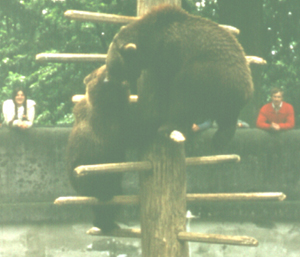
There are many such sites in France and Switzerland. In fact the legacy of bear worship continues to this day. And the capital city of Switzerland Berne (meaning Bear) still has the bear pits - for a long time now a tourist attraction where you can throw carrots to the bears.
Bears still have a special place in our homes and hearts and minds. A cuddly toy bear is an essential part of nursery equipment and we go on putting them in our beds or collecting them, treasuring them, almost seeing these toys as living pets. And this did not happen until the bear itself was a rarely seen zoo exhibit - and not for people who still face real bears.
At the beginning of the 20th century, when the bear became a teddy bear - a nursery toy, in Siberia bears were still held in special respect.
Bears were believed to the be representive of justice on Earth. Oaths were taken on a bear's paw. They would kiss the paw and say "May I be mauled by a bear, should what I say be a lie".
The bear was not mentioned directly by its name but referred to by a title such as "Master of the Forest". When hunters killed a bear, they would embrace it (Vladillen Tugolukov: Pathfinders on Reindeer Back, 1969)- even have sex with it - after it was dead presumably. That was a custom taken into North America. It may be how syphilis got into the human population when it was not endemic in Siberia, only in America - and in bears. The idea was keep the bear's spirit amicably disposed to its killers.
They still hold Bear Feasts. (I did not enquire too closely about the other, except to observe the word was not in my dictionary). All the neighbours and guests would gather for the Bear Festival. When the bear is brought back to the village, women and girls throw snowballs (or water) at the hunters carrying the bear. Women were not allowed to attend the feast on the first day of the festival which may last up to five days. The bear skin was stuffed and sat at the feast. The bear's meat was eaten at the feast. Everyone dressed in their best clothes and performed masked plays, danced and sang songs. Afterwards the bear's bones were laid out in a special way to enable its resurrection.
More on Western Siberian, Mansi, bear festival
In the far east of Siberia and north Japan, a bear cub was hand raised as a special pet, then sacrificed.
Stories survive in western Siberia, in which the Bear is the son of God (that is the Supreme Being or Sky God - as in many cosmological systems. His Father lowered him to Earth in a golden cradle (identified as the "Great Bear" constellation), and taught him how to make a fire and to hunt with weapons so he shall never be cold and hungry. At the same time he was told never to attack human. In fact the Bear was on a mission to see that honesty and justice reigned among mankind. But he forgot this, and attacked people. So men killed him and took possession of fire and weapons.
So the Bear is a culture hero bringing benefits to mankind - and also associated with the cycle of the seasons through the year and life, death and rebirth.
Surviving ritual New Year festivities in some parts of Eastern Europe still enact this association of the Bear being killed, then brought by to life by a shaman like figure.
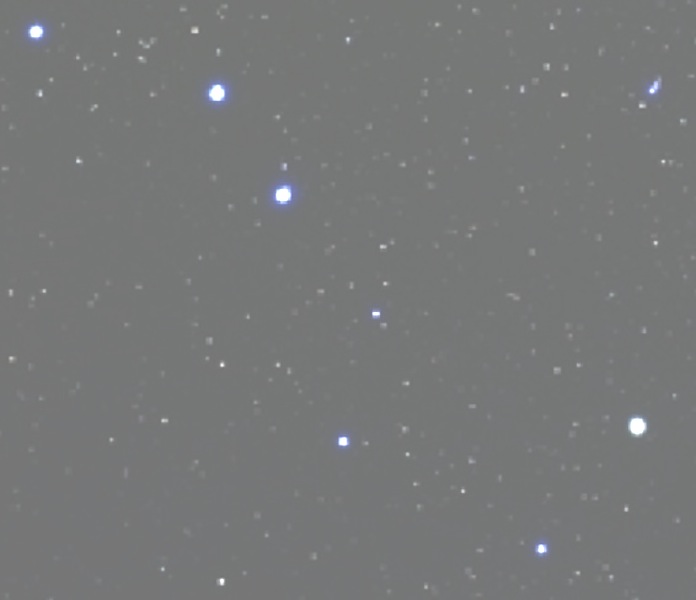 This association of the Bear, the Great Bear constellation and the changing seasons is found in North American legends, like this one (from E. Clark, Indian Legends of Canada, 1973). They show how the Plough or Great Bear constellation goes around the sky, through the year and through the night, acting as a nightime clock and calendar. This story (abbreviated here) about the Great Bear constellation follows her progress and changing position right through the year. It shows the changing position in the night sky and the seasons and association of the bear with life - killed in the autumn, she is reborn in the spring.
This association of the Bear, the Great Bear constellation and the changing seasons is found in North American legends, like this one (from E. Clark, Indian Legends of Canada, 1973). They show how the Plough or Great Bear constellation goes around the sky, through the year and through the night, acting as a nightime clock and calendar. This story (abbreviated here) about the Great Bear constellation follows her progress and changing position right through the year. It shows the changing position in the night sky and the seasons and association of the bear with life - killed in the autumn, she is reborn in the spring.
"Late in the spring, every year, the bear wakes from her long sleep, leaves her den, and goes in search of food. Chickadee catches sight of her and calls other hunters to assist him. With Chickadee and his pot (the double star) between Robin and Moose Bird, they chase the bear across the northern sky throughout the summer.
About the middle of autumn they overtake the bear who rears up on her hind legs. But Robin shoots her with his arrow and she falls over on her back. Robin is splattered with blood which splashes on the leaves of the trees below. Chickadee cooks the bear in his pot.
Thought the winter, the skeleton of the bear lies on its back in the sky. But her life spirit has entered another bear that lies upon her back in her den, invisible, hibernating. When spring comes round again, this bear will again leave her den and will be pursued by the hunters. She in turn will be slain but will send her life spirit to her den, from which she will come forth again when the sun once more awakens the sleeping earth."
In legends from Europe and Siberia, an elk steals the Sun in her antlers and is chased by the three hunters, one carrying a pot all night until they kill the elk and restore the Sun to rise again next morning. Next evening her daughter begins the hunt all over again.
These legends are pictured in rock drawings in places in Europe and Siberia. In Italy and Spain too far south for elk,there is a deer.
In Siberia they were places where the spring hunting ritual was carried or commemorated and sacrifices made for a successful hunting season, because many of these places are still sacred and in use for centuries.
Female elk do not have antlers, and surviving Siberian legends, in which the part of female elk or female bear is played by the Great Mammoth Mother, gives a clue to the origins of both elk and bear stories with the mammoth hunters across the steppe tundra of Europe and Siberia, from 55,000 years ago to about 12,000 years ago. (The last mammoths died out about 4,000 years ago).
Another clue to the ancient origins of this legend is that the mammoth dips into the sea and becomes half fish symbolically between the upper and lower worlds.
The myth must date from a time and latitude when Ursa Major dipped below the horizon for part of the year, as Cygnus does now.
When mammoths had become an ancient myth - the memory of a shaggy beast became the bear, and the memory of the tusks catching the sun became the antlers of a female elk.
In Europe and Siberia, this constellation was seen as a mother elk with antlers. Amongst recorded legends are several in which the Cosmic Elk steals the Sun and is chased through the night by a hero/god, or twin heroes, or three hunters, the middle one carrying a cooking pot (the double star). They kill the Elk and the sun rises again. Although the Elk is dead, her daughter (Ursa Minor) survives and the hunt begins again. (Anisimov: 1963).
The Cosmic Hunt is illustrated in rock drawings. (Okladnikov: 1972). The skies were mapped not as actually observed but with the mythical beings and events associated with the patterns of stars. Rock drawings of this type in Spain and in Yakutia have been dated to about 6,000 years ago.
Excavations by a rock drawing of this kind constantly redrawn and maintained as a sacred site, in Yakutia, found offerings dating from the late Neolithic to the 19th century.
In Siberia hunters always carried out a spring hunting ritual symbolizing the killing of the Cosmic Elk. In March this constellation is overhead.
It has not always been the same, as the Earth wobbles and the north pole moves, in a 26,000 year cycle. Although it is never exactly back to the same place, this is predictable enough to be useful in dating ancient star charts, and even rock drawings and stories about the constellations.
In Canadian myths, the Ursa Major constellation is a female bear. She is chased throughout the year by three hunters - the middle one with the pot, and in autumn she is killed, her blood stains the leaves. She lies on her back all winter, then in spring her daughter rises and the hunt begins again. (Clark: 1973).
The American continent became populated by people from Eastern Asia from at least 30,000 years ago, when they would have travelled mainly by boat along the coastlines, since the North Pacific was warmer as the Bering Straits were continuous land which blocked the Arctic Currents. New people continued to travel across the North Pacific and the Bering Straits, after the ice age, so there are cultural similarities.
To the ice-age mammoth-hunters who used Mammoth bones and hides to build their homes, the constellation appeared a little different to the way we see it today. That is because our Sun with its planets is moving at 43,400 miles an hour. It travels 380 million miles each year, and is presently passing through a cluster of stars which includes five of the stars in the Plough and the star Sirius which can be see twinkling bright pale blue near the horizon in the Southern sky in winter. Two of the stars in the Plough have nothing to do with the other five, they just appear by chance to us to be part of the pattern of the constellation. So as we are moving the position we see these stars changes relative to the others.
In China, Tao magicians put the Plough constellation in the centre of their divining boards which had the significant directions all around. They made a spoon-shaped model of lodestone, and the handle always pointed south. It was the first compass. The idea had come from the spoon-shaped carved antler sticks representing the Plough used by Siberian shamans to beat their tambourines and also for divining by observing the direction they pointed when thrown down.
The Song of the Stars
(Algonquin - Canada)
We are the stars which sing,
We sing with our light;
We are the birds of fire,
We fly over the sky.
Our light is a voice;
We make a road for spirits,
for the spirits to pass over.
Among us are three hunters
Who chase a bear;
There never was a time
When they were not hunting.
We look down on the mountains.
This is the song of the stars.
What happens to the Great Bear/Cosmic Elk is seen further south nearer the equator so dips over the horizon for part of the year. It becomes a crocodile!
looking beyond "the Cosmic Elk" (Plough constellation) with Hubble to NGC 2841
Loading player...
More about the Northern Stars
In northern regions, the circumpolar stars seen every clear night as they appeared to rotate around the north celestial pole, served as a night time clock. Used by reindeer herders to time their night watch. But when I asked an Evenk ethnographer how it was done, he said that no one knew.
The main circumpolar constellations forming a triangle around the north pole are Ursa Major, Cassiopeia, and Cygnus the great cross-shaped swan. The Milky Way runs across Cassiopeia and Cygnus.
Cygnus
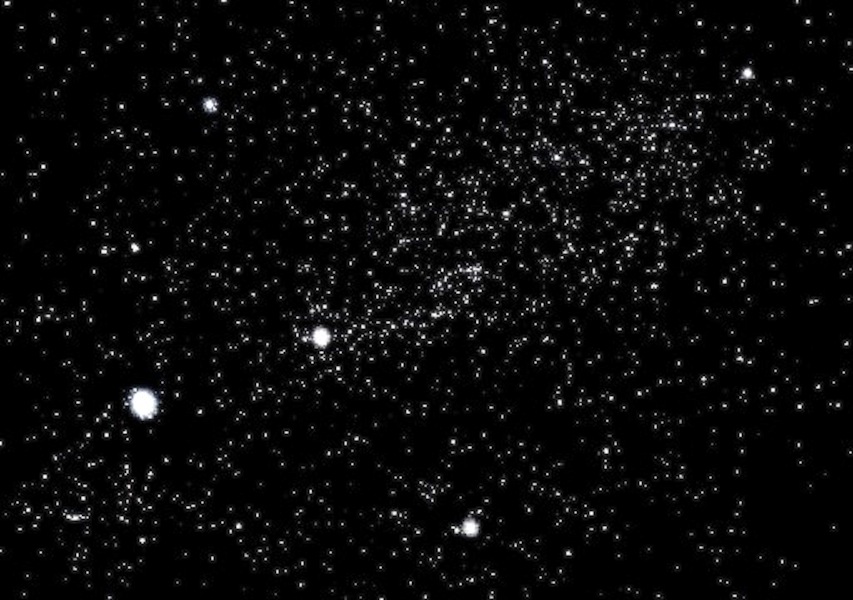
has been seen as a swan for a very long time. This may be the phallic looking Swan pendant worn by the mammoth hunters at the sites near the Angara River in Central Siberia some 25,000 years ago. At that time the constellation was circumpolar and seen nearly overhead. (more on this)
For the past few thousand years it dips partly below the horizon in the autumn. In legends it is the Swan Prince leading the birds away across the Milky Way each autumn to Bird World, and bringing them back in spring. The migration of birds was one of the ways that the calendar was fixed by the shamans.
In some legends it is a god/hero giving chase who may be identified with the Sun and with the constellation of Cygnus the Swan on the Milky Way.You an see his ski tracks behind him. Cygnus dips down in the West in Autumn and reappears in the East in Spring.
He is in legends as the leader of the birds, taking them away to Birdworld for the winter. He is also in mythology and religious beliefs as leading the souls of the dead across the Milky Way to the place of the dead.
Amongst North American Indians, newborn babies were given moccasins with holes in, so they could resist the call to travel back over the Milky Way, or "pebbly river" as their shoes were too bad.
By the Iron Age this god was a hero riding a horse. Often a headless horse. Often killing a dragon. He symbolised the coming winter, and the banishing of winter in the spring. This can be seen in ancient rock art, Yukaghir women wore a pendant with a rider which anthropologists thought looked like St. George, and that does show the orgins of the the image and legend of St. George and also survives in other folk lore today. Such as the story of Bayards Leap (near RAF Cranwell). And why the 3 sets of horse-shoes were kept until recently. Images of sets of horse shoes also survived in Scandinavia and Western Siberia. They were the footprints of the sun god "world watching man" or "world surveyor man".
More on the Swan Prince/Sun god/World Surveyor Man.
Cassiopeia |
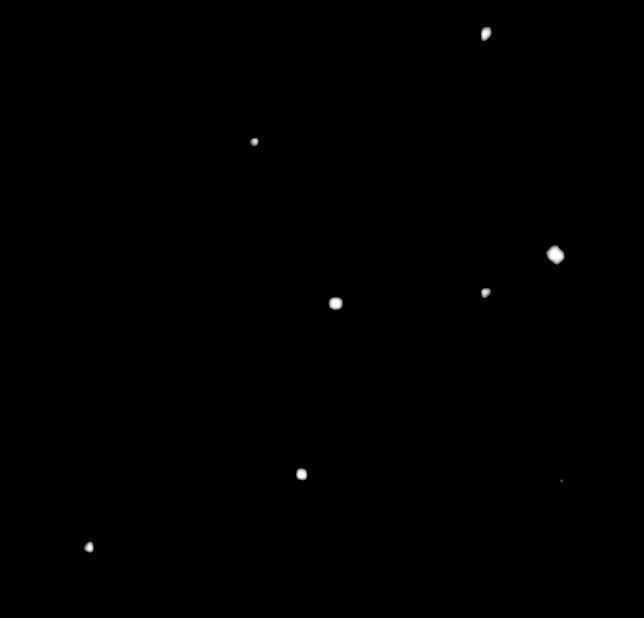
|
Don't worry about the complicated ancient Greek legends. This constellation was another important mythical bird who still appears in our iconography and myths today. She was the double-headed eagle that brought ruling powers to man and survives as the imperial emblems used by the Romanovs and the Hapsburgs. More details here. |
More about the Plough
The main timekeeper in the northen sky is Ursa Major, the Great Bear, (or Cosmic Elk) which appears to rotate about the north celestial pole each night and through the year, making it a clock and a calendar. A "pole star" has never actually existed though there was a star called Polaris that came within half a degree during the 1970s but is shifting away now. The position of the north pole relative to the stars changes over time in an approximately 26,000 year cycle caused by the Earth wobbling on its axis, and never comes back exactly to the same place. More on the procession of pole and the zodiac.
This also affects the constellations of the ecliptic (apparent path of the sun) so it appears the sun is moving through the constellations in time as well as through the year. 2,000 years ago (according to the Roman zodiac) the sun appeared to cross the ecliptic from south to north in the spring equinox in Taurus the Bull (important in a Roman cult then associated with the sun god) but this was about to take place in the next constellation, Pisces - the Fishes. Astrology depends on the position of the sun and planets in the zodiac of constellations about the ecliptic and how they are supposed to affect your life. They don't of course. But it can be useful for historians.
Stars seen north and south
Pleiades and Orion
  Constellations like the Pleiades and Orion can be seen north and south of the equator. In Australian myths, the Pleiades were also seen as "seven sisters". Both pictures show view from northern hemisphere, where they appear in the southern sky in winter. Constellations like the Pleiades and Orion can be seen north and south of the equator. In Australian myths, the Pleiades were also seen as "seven sisters". Both pictures show view from northern hemisphere, where they appear in the southern sky in winter.
The Pleiades were used as a marker for the coming winter or the beginning of the year, by people both north and south of the equator.
Orion, and the constellations around the ecliptic are seen below the equator in the southern hemisphere, looking towards the north.
In the north Orion was seen as a god associated with reaping the harvest or hunting. The 3 stars coming down from the "belt" referred to as Orion's sword was originally seen as a certain part of his body. With even a small telescope this area can be seen as clouds of new stars forming out of dust and gas. The bright star looking like Orion's football - Sirius, (seen as Orion's dog) which was used to mark the year in Egypt where it is more obvious, is actually part of the cluster of stars forming part of the "Plough" constellation. Our sun is moving through that cluster. Hence the Plough is to our north and Sirius in the south. Stars usually form in clusters like we can see in the Pleiades, but can get blasted out of them by something happening to them on their journey around the centre of the galaxy, which seems to have happened to our Sun.
On the north shores of Australia, Orion was seen as three men fishing from their canoe. The rising of this constellation heralded the coming of the Wet season, and the storms. In the myth, the three men went out to fish because their families were hungry. So they caught fish which they were not supposed to eat, that were taboo. But then they were caught in the coming storms and a great whirlpool lifted them into the sky, where they can be seen. The three men in their canoe, and two nets of fish they are dragging. The nets are the Hyades and the Pleiades which are groups of new, still fluffy, stars, above Orion in the north, Hyades, then the Pleiades.
In Thailand - just north of the equator, the Pleiades were fluffy little chicks. They belonged to an old couple who were very poor. But a monk arrived and sat down outside their little home. They had to feed him, but all they had was their hen who was looking after her fluffy chicks. They had to put the hen in the cooking pot to feed the monk. The little chicks were so upset by losing their mother they jumped into the pot to be with her. The hen and her chicks went up to heaven where you can see them today.
Southern Stars
South of the equator - many bright stars and constellations have been used for timekeeping and navigation. And have their part in their own legends. Some could be even older. Dating back to the earliest of humans, nearly 2 million years ago.
Many beliefs can be traced back to the early humans in south-east Asia. Here there really were dragons, giant serpents, and here also watching the stars and remembering their postions through the seasons, became important.
Emu in the Sky
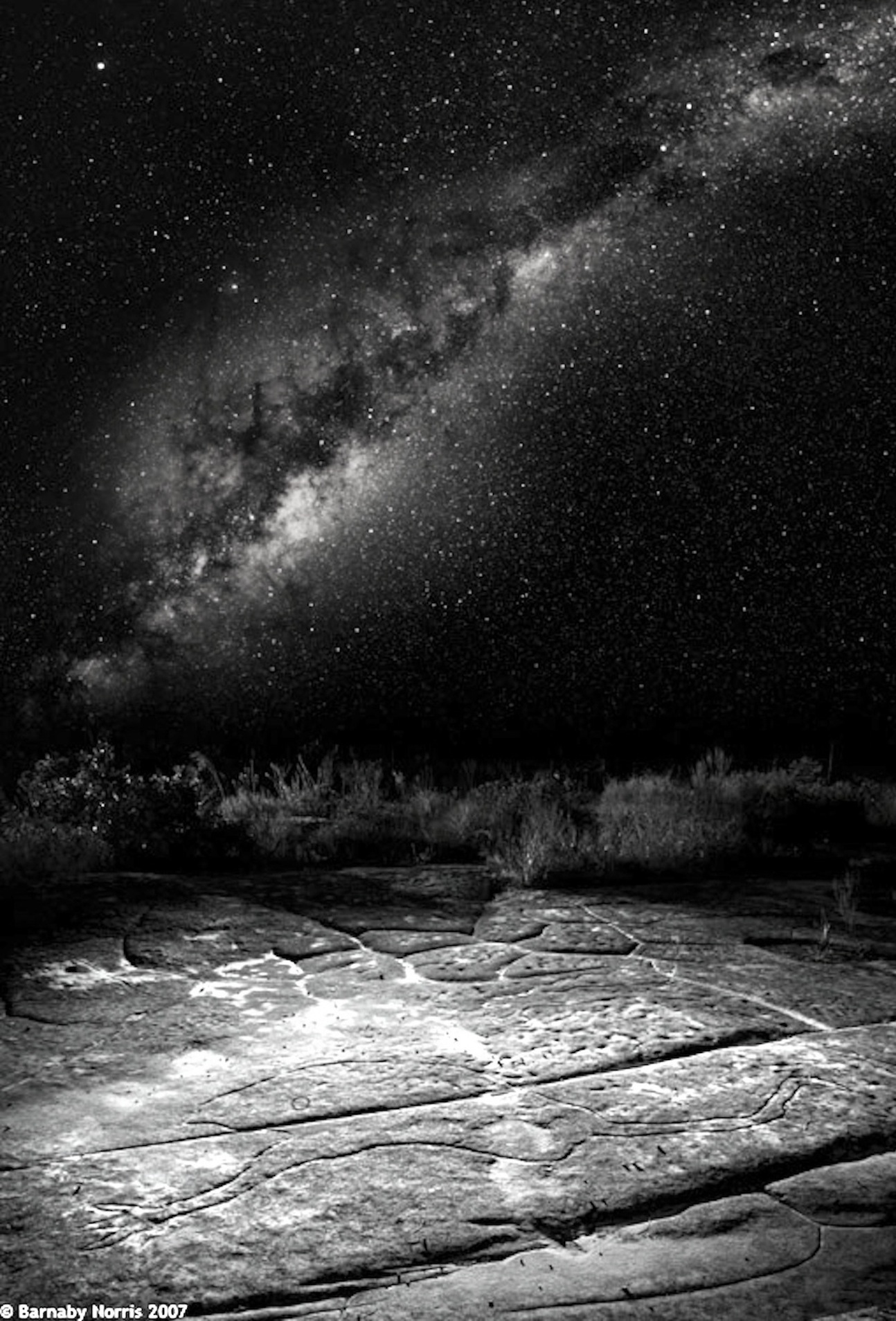
As the constellation of Cygnus the Swan, was an important marker of the coming autumn as well as significant in their beliefs, so Australians also had a special celestial bird in the sky. Rock drawings survive, in the Ku-ring-gai Chase National Park, just north of Sydney, of the Emu in the Sky. Like Cygnus, this mythical bird constellation is in the Milky Way. However this bird on the other side of the Milky Way, is totally different to other constellations, which are join-the-dots images of the stars. For the Emu is the absence of stars, the black dust clouds in the Milky Way. Which shows how clear the sky was once in the region of Sydney. (And how sharp the eyesight of the people whose home it was).
The award-winning photo by Barnaby Norris, shows the Emu in the Sky standing upright above her engraving. This occurs at the time of the year when Emus lay their eggs, which were an important food source for the Ku-ring-gai people.
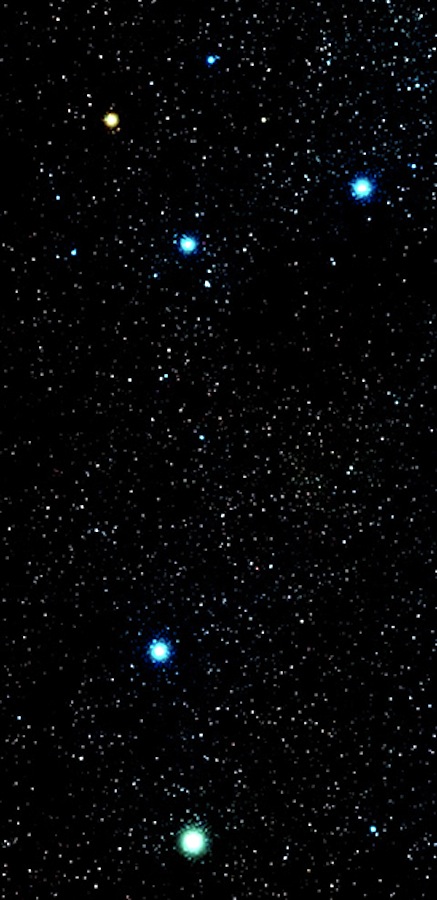 Southern Cross
The pole finding constellation in the southern hemisphere.
Just as the northern circumpolar stars cannot be seen south of the equator, so the southern circumpolar stars can only be seen in the southern latitudes. The constellation that marked the coming of winter in Australia and south America was the Southern Cross. When I finally was able to see this in Sydney, I was impressed by how clear it was, even in the centre of this conurbation of some 6 million.
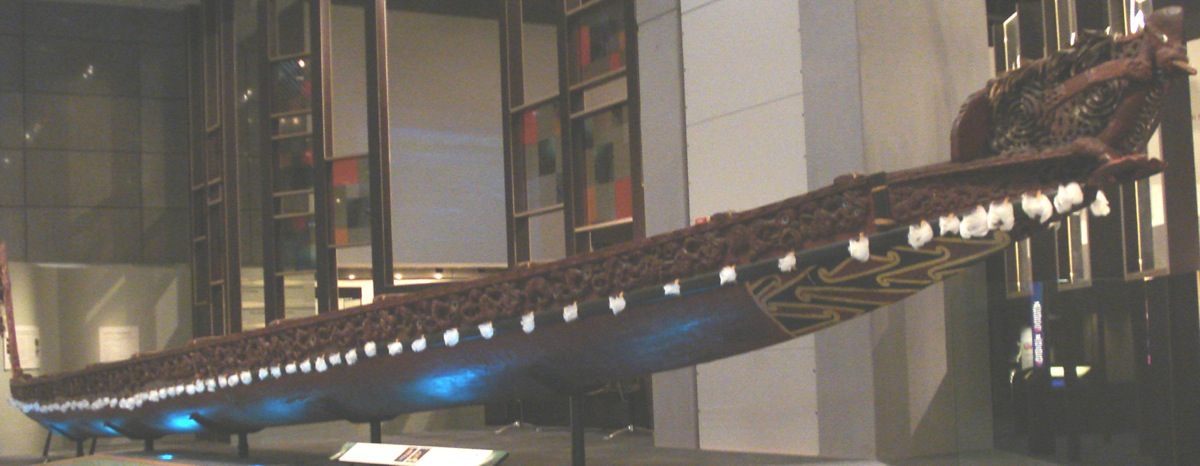
Yet in New Zealand, the Southern Cross was just part of a vast constellation, stretching across the sky from Orion, the anchor of one of the wooden ships, (picture taken in museum in Wellington) in which the voyagers from South East Asia, over the course of thousands of years, conquered the scattered islands of the South Pacific and probably parts of the west coast of America, and finally arrived in New Zealand.
More on the stars and constellations with useful links to come.
More links:
| This webpage written, designed and maintained by Heather Hobden | The Cosmic Elk
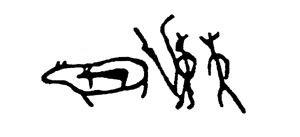 |
|

 This association of the Bear, the Great Bear constellation and the changing seasons is found in North American legends, like this one (from E. Clark, Indian Legends of Canada, 1973). They show how the Plough or Great Bear constellation goes around the sky, through the year and through the night, acting as a nightime clock and calendar. This story (abbreviated here) about the Great Bear constellation follows her progress and changing position right through the year. It shows the changing position in the night sky and the seasons and association of the bear with life - killed in the autumn, she is reborn in the spring.
This association of the Bear, the Great Bear constellation and the changing seasons is found in North American legends, like this one (from E. Clark, Indian Legends of Canada, 1973). They show how the Plough or Great Bear constellation goes around the sky, through the year and through the night, acting as a nightime clock and calendar. This story (abbreviated here) about the Great Bear constellation follows her progress and changing position right through the year. It shows the changing position in the night sky and the seasons and association of the bear with life - killed in the autumn, she is reborn in the spring.


 Constellations like the Pleiades and Orion can be seen north and south of the equator. In Australian myths, the Pleiades were also seen as "seven sisters". Both pictures show view from northern hemisphere, where they appear in the southern sky in winter.
Constellations like the Pleiades and Orion can be seen north and south of the equator. In Australian myths, the Pleiades were also seen as "seven sisters". Both pictures show view from northern hemisphere, where they appear in the southern sky in winter.


